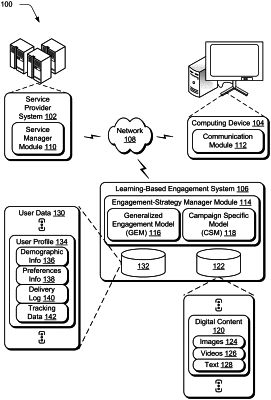| CPC G06Q 30/0244 (2013.01) [G06N 5/00 (2013.01); G06N 20/00 (2019.01); G06Q 30/0242 (2013.01); G06Q 30/0254 (2013.01); G06Q 30/0255 (2013.01); G06Q 30/0264 (2013.01)] | 19 Claims |

|
1. A method comprising:
receiving, via a user interface and by at least one computing device, user input to define aspects of a user-created multi-step engagement strategy for controlling delivery of content associated with a campaign, the defined aspects including an entry condition, an exit condition, and at least two content deliveries to client device users targeted by the campaign based on the entry condition;
generating, by the at least one computing device, one or more randomly varied multi-step engagement strategies that differ from the user-created multi-step engagement strategy;
training, using data describing interactions with the content delivered according to both the user-created multi-step engagement strategy and the one or more randomly varied multi-step engagement strategies, one or more machine learning models to predict a class corresponding to a different multi-step engagement strategy;
generating, by the at least one computing device and using the one or more machine learning models, a prediction of the different multi-step engagement strategy based on the class corresponding to the different multi-step engagement strategy and based on the delivery of the content associated with the campaign according, in part, to both the user-created multi-step engagement strategy and the one or more randomly varied multi-step engagement strategies; and
presenting, by the at least one computing device and via the user interface, a visualization of the prediction of the different multi-step engagement strategy, wherein the visualization includes indications of at least two content deliveries controlled by the prediction of the different multi-step engagement strategy.
|